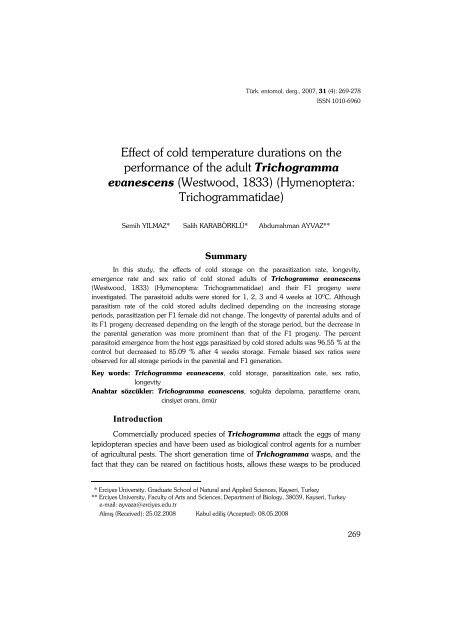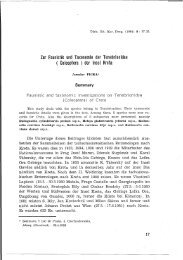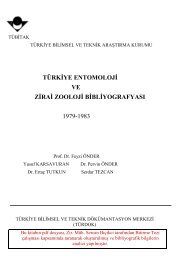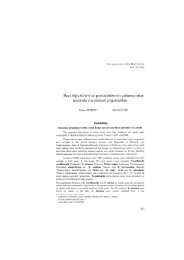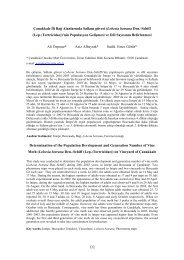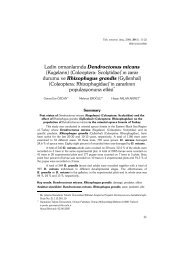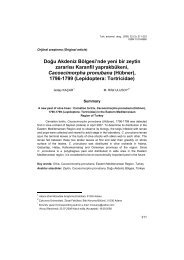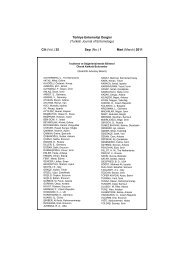Trichogramma evanescens
Trichogramma evanescens
Trichogramma evanescens
Create successful ePaper yourself
Turn your PDF publications into a flip-book with our unique Google optimized e-Paper software.
Türk. entomol. derg., 2007, 31 (4): 269-278<br />
ISSN 1010-6960<br />
Effect of cold temperature durations on the<br />
performance of the adult <strong>Trichogramma</strong><br />
<strong>evanescens</strong> (Westwood, 1833) (Hymenoptera:<br />
<strong>Trichogramma</strong>tidae)<br />
Semih YILMAZ* * Salih KARABÖRKLÜ* Abdurrahman AYVAZ**<br />
Summary<br />
In this study, the effects of cold storage on the parasitization rate, longevity,<br />
emergence rate and sex ratio of cold stored adults of <strong>Trichogramma</strong> <strong>evanescens</strong><br />
(Westwood, 1833) (Hymenoptera: <strong>Trichogramma</strong>tidae) and their F1 progeny were<br />
investigated. The parasitoid adults were stored for 1, 2, 3 and 4 weeks at 10ºC. Although<br />
parasitism rate of the cold stored adults declined depending on the increasing storage<br />
periods, parasitization per F1 female did not change. The longevity of parental adults and of<br />
its F1 progeny decreased depending on the length of the storage period, but the decrease in<br />
the parental generation was more prominent than that of the F1 progeny. The percent<br />
parasitoid emergence from the host eggs parasitized by cold stored adults was 96.55 % at the<br />
control but decreased to 85.09 % after 4 weeks storage. Female biased sex ratios were<br />
observed for all storage periods in the parental and F1 generation.<br />
Key words: <strong>Trichogramma</strong> <strong>evanescens</strong>, cold storage, parasitization rate, sex ratio,<br />
longevity<br />
Anahtar sözcükler: <strong>Trichogramma</strong> <strong>evanescens</strong>, soğukta depolama, parazitleme oranı,<br />
cinsiyet oranı, ömür<br />
Introduction<br />
Commercially produced species of <strong>Trichogramma</strong> attack the eggs of many<br />
lepidopteran species and have been used as biological control agents for a number<br />
of agricultural pests. The short generation time of <strong>Trichogramma</strong> wasps, and the<br />
fact that they can be reared on factitious hosts, allows these wasps to be produced<br />
*<br />
* Erciyes University, Graduate School of Natural and Applied Sciences, Kayseri, Turkey<br />
** Erciyes University, Faculty of Arts and Sciences, Department of Biology, 38039, Kayseri, Turkey<br />
e-mail: ayvaza@erciyes.edu.tr<br />
Alınış (Received): 25.02.2008 Kabul ediliş (Accepted): 08.05.2008<br />
269
quickly and affordably relative to other parasitoids (Li, 1994; Smith, 1996).<br />
Augmentative release of <strong>Trichogramma</strong> wasps offers a promising new approach<br />
for managing stored-product moths (Grieshop et al., 2006). The polyphagous egg<br />
parasitoid <strong>Trichogramma</strong> <strong>evanescens</strong> (Westwood, 1833) (Hymenoptera:<br />
<strong>Trichogramma</strong>tidae) are commercially applied in the retail trade and the food<br />
processing industry in Germany to control stored-product moths, mainly the Indian<br />
meal moth Plodia interpunctella (Hübner) (Lepidoptera: Pyralidae), the<br />
Mediterranean flour moth Ephestia kuehniella Zeller (Lepidoptera: Pyralidae),<br />
and the warehouse moth Ephestia elutella (Hübner) (Prozell & Schöller, 1998)<br />
(Lepidoptera: Pyralidae). Steidle et al. (2001) <strong>Trichogramma</strong> species<br />
(<strong>Trichogramma</strong> brassicae Bezdenko, <strong>Trichogramma</strong> pretiosum Riley and<br />
<strong>Trichogramma</strong> carverae Oatman & Pinto) were assessed for their suitability as<br />
bio-control agents against Ephestia cautella (Walker) (Lepidoptera: Pyralidae)<br />
and E. kuehniella which are important pests in food manufacturing and<br />
processing facilities in Australia.<br />
The egg parasitoid <strong>Trichogramma</strong> as a biological control agent requires<br />
that large numbers should be produced by commercial insectaries. Because field<br />
requirements can vary, it is desirable to store large numbers of parasitoids to meet a<br />
fluctuating demand (Bradley et al., 2004). Storage of these parasitoids assures their<br />
availability in sufficient numbers at the time of release (Tezze & Botto, 2004). Cold<br />
storage can permit a more cost-effective production schedule (Glenister &<br />
Hoffmann, 1998). It may also be a means to conserve biological control agents<br />
when not immediately needed (Pitcher et al., 2002). The variation in<br />
<strong>Trichogramma</strong> strains for cold tolerance and adaptability to low temperatures<br />
makes this a useful criterion for evaluation of candidate strains for inundative<br />
releases in cold conditions (Voegelé et al., 1988). A number of <strong>Trichogramma</strong><br />
species have been tested by exposing the insects to cold storage conditions (Vigil,<br />
1971; Jalali & Singh, 1992; Piao et al., 1992; Bradley et al., 2004; Özder &<br />
Sağlam, 2004; Kumar et al., 2005; Karabörklü & Ayvaz, 2007). Much of these<br />
studies report the amenability of the immature stages of <strong>Trichogramma</strong> species<br />
against cold storage. It is important to test the suitability of each particular species to<br />
cold since not all of them are able to be cold stored (Tezze & Botto, 2004).<br />
Few studies were reported on the cold tolerance of the <strong>Trichogramma</strong><br />
adults. The determination of cold tolerance of the adult parasitoids would be useful<br />
for some parasitoid release programs. Because, conservation of adult biological<br />
control agents would be applicable when the weather conditions changed<br />
unexpectedly during release period. We aimed to determine the amenability of<br />
T. <strong>evanescens</strong> adults to the cold and to estimate the effect of such storage on the<br />
quality of the adult parasitoid and its F1 progeny. In the current study, we have<br />
tested the tolerance of T. <strong>evanescens</strong> adults at low temperature and determined<br />
parasitization rate, longevity, emergence and sex ratio after cold storage.<br />
270
Material and Methods<br />
Insect culture<br />
E. kuehniella stock culture was obtained from laboratory colonies at the<br />
Department of Plant Protection, Faculty of Agriculture, Ankara University.<br />
E. kuehniella larvae were reared on a mixture consisting of 1 kg wheat flour, 55<br />
g yeast and 30 g wheat germ (Marec et al., 1999), and the rearing conditions<br />
were 27 ± 1 °C, 70 ± 5% R. H., and a photoperiod of 14:10 h (L:D). This<br />
culture was maintained under these rearing conditions for about 40 generations.<br />
T. <strong>evanescens</strong> were originally collected from eggs of Ostrinia nubilalis<br />
Hübner (Lepidoptera: Pyralidae) sampled in Adana, Turkey. They were reared on<br />
ultraviolet sterilized E. kuehniella eggs at 27 ± 1 °C, 70 ± 5% R.H., and a<br />
photoperiod of 14:10 h (L:D). Eggs were irradiated with ultraviolet light for 20 min<br />
(Mineralight Lamp, Shortwave UV, 254 NM, 215-250 Volts, 56/60 Hz, 0.12 AMPS).<br />
Cold storage of <strong>Trichogramma</strong> <strong>evanescens</strong> adults<br />
Freshly laid E. kuehniella eggs were glued with gum Arabic (Merck,<br />
Darmstadt, Germany) on each prepared cardboard. The cards were separately put<br />
in glass vials (1.6 cm diameter x 10 cm height) for 24 h with 1-day old<br />
T. <strong>evanescens</strong> adults at rearing conditions (27 ± 1 °C, 70 ± 5% R.H. with a<br />
photoperiod of 14 h light and 10 h dark). The parasitized eggs were incubated at<br />
the rearing condition until adult emergence. The adults emerged were put into glass<br />
vials individually. The glass vials containing adult parasitoid were stored at 10 °C,<br />
70 ± 5 % R.H. and in constant darkness at one week intervals for 4 weeks. Fifteen<br />
replicates were used for each storage period. Controls were subjected to the normal<br />
rearing conditions (27 ± 1 °C, 70 ± 5 % R.H. with a photoperiod of 14 h light and<br />
10 h dark) and compared with cold-exposed groups.<br />
Parasitism rate of cold stored adults and of its F1 progeny<br />
The glass vials containing cold stored adults then were transferred to normal<br />
rearing condition. The wasps were provided egg cards consisting of fresh<br />
E. kuehniella eggs (approximately 40 ± 5 host eggs for each wasp) for 24 h. A<br />
drop of 15 % honey/water solution was supplemented as a food source. The<br />
parasitized eggs were detected by their black color indicating that the parasitoid<br />
larvae within the host egg had pupated. The number of emerged adults was also<br />
determined by counting both emerged adults and emergence holes on the host<br />
eggs. The percentage of female adults and sex ratio were estimated. The parasitism<br />
performance of the F1 progeny obtained from cold stored adults was also evaluated<br />
as in the parental generation. Fifteen replicates were used for parasitization trials of<br />
F1 progeny.<br />
271
272<br />
Longevity of cold stored adults and of its F1 progeny<br />
After 24 h parasitization period T. <strong>evanescens</strong> females from every trial<br />
group were isolated in a separate glass tube. The longevity of adult females for each<br />
storage period was noted from the time adults emerged to the time of their death.<br />
A drop of honey/water solution was added until the wasp died and wasps drowning<br />
in honey droplets were discounted. The longevity was also determined of F1<br />
progeny for each storage period as in the parental generation.<br />
Statistical analysis<br />
Data from the experiments were subjected to analysis of variance (ANOVA)<br />
using SPSS for Windows, version 10.0 (SPSS Inc. Chicago, IL, USA). Data were<br />
transformed using arcsine √x transformation to meet normality, which is<br />
recommended for ANOVA (Steel & Torrie 1980). Means were separated at the 5%<br />
significance level by using the Tukey-Kramer HSD posttest.<br />
Results and Discussion<br />
Effect of cold storage on the parasitism rate of parental adults and<br />
of its F1 progeny<br />
Long-term cold storage reduced the parasitism performance of parental<br />
T. <strong>evanescens</strong> (Table 1). The mean parasitization per female was significantly<br />
reduced after cold exposure depending on the length of exposure time (F=27.19;<br />
d.f.=4; P0.05). The mean parasitization of F1 progeny was ranged from 33.12 to 36.14<br />
after 4 weeks of storage.<br />
The emergence rate and percentage of female adults of the F1 progeny did<br />
not change depending on the cold storage periods (for adult emergence, F=2.23;<br />
d.f.=4; P>0.05, for percentage of female emergence F=1.06; d.f.=4; P>0.05)<br />
(Table 2). Female biassed sex ratios were also evident in the F1 generation ranging<br />
2.39 for untreated control to 1.71 for 4 week storage period (Table 2).
Table 1. Parasitization performance of the cold stored parental adults of <strong>Trichogramma</strong> <strong>evanescens</strong><br />
(Westwood) on Ephestia kuehniella Zeller at 27 ºC<br />
Storage<br />
(Week)<br />
Parasitization<br />
per female<br />
(Mean ± SE)<br />
Percent adult<br />
emergence<br />
(Mean ± SE)<br />
Percentage<br />
of female<br />
(Mean ± SE)<br />
Sex ratio<br />
(Female/Male)<br />
Control 36.26 ± 1.26a * 96.55 ± 1.43a 64.08 ± 6.71a 1.78<br />
1 26.06 ± 0.57b 94.28 ± 2.36a 61.05 ± 7.20a 1.56<br />
2 22.35 ± 1.28b 98.74 ± 1.05a 62.39 ± 7.99a 1.65<br />
3 21.63 ± 0.90c 88.91 ± 1.05b 54.28 ± 7.42a 1. 18<br />
4 21.57 ± 0.88c 85.09 ± 1.23b 52.87 ± 8.85a 1.12<br />
* Means followed by the same letter in a column are not significantly different at P
274<br />
Number of surviving adult<br />
16<br />
14<br />
12<br />
10<br />
8<br />
6<br />
4<br />
2<br />
0<br />
Control 1 week 2 week 3 week 4 week<br />
1 2 3 4 5 6 7 8 9 10 11<br />
Figure 1. Longevity of the parental adults of <strong>Trichogramma</strong> <strong>evanescens</strong> (Westwood) at normal<br />
rearing condition after cold storage.<br />
The decrease is more prominent in the parental adults than in the F1<br />
generation. Mean longevity of parental adults was 2.0 day after stored for 4 weeks,<br />
but F1 adults lived longer (5.0 day) at the same storage period (Figure 1 and 2).<br />
Number of surviving adult<br />
16<br />
14<br />
12<br />
10<br />
8<br />
6<br />
4<br />
2<br />
0<br />
Day<br />
Conrol 1 week 2 week 3 week 4 week<br />
1 2 3 4 5 6 7 8 9 10 11<br />
Day<br />
Figure 2. Longevity of the F1 progeny of the cold stored <strong>Trichogramma</strong> <strong>evanescens</strong> (Westwood)<br />
adults at normal rearing condition.<br />
Despite the decrease in the longevity of the F1 progeny, the parasitization<br />
rate and adult emergence was not different from the control group. This showed<br />
that T. <strong>evanescens</strong> can be stored at 10 °C up to 4 weeks without much loss of its<br />
performance in the F1 progeny. In terms of the activity of F1 progeny, similar<br />
results were reported for Trichogramme ostriniae (Peng & Chen) stored at 6°C<br />
(Pitcher et al., 2002). Piao et al. (1992) found no difference in the post storage<br />
parasitism rate and progeny production for Trichogramme dendrolimi
Matsumura females stored within parasitized eggs up to 30 days at 3-5 °C. Kumar<br />
et al. (2005) reported that Trichogramme brasiliense Ashmead can be stored for<br />
10 days while Trichogramme chilonis Ishii and T. pretiosum can be stored for<br />
20 days at 4 ± 0.5 °C without adversely affecting their emergence and<br />
parasitization efficiency.<br />
At present study, the longevity of parental and F1 adults decreased depending<br />
on the length of storage period. Bradley et al. (2004) investigated the effect of storage<br />
temperature (4°C, 8°C, and 10°C) and time (1–8 wk) for T. carverae. They showed<br />
that lower temperatures (
erginlerden gelişen F1 erginlerinin parazitleme oranlarında önemli bir azalma gözlenmemiştir.<br />
Soğuğa maruz bırakılan erginler ve bunlardan gelişen F1 erginlerinin ömürleri, depolama<br />
süresine bağlı olarak azalmıştır; fakat ömür uzunluğundaki azalma atasal erginlerde F1<br />
erginlerine göre daha belirgin olmuştur. Parazitlenen yumurtalardaki erginlerin çıkış oranı<br />
kontrolde % 96.55 iken, bu oran 4. hafta sonunda % 85.09’a gerilemiştir. Tüm depolama<br />
peryotlarında, soğuğa maruz bırakılan erginler ve bunlardan gelişen F1 erginlerinin cinsiyet<br />
oranı dişiler lehinde olmuştur.<br />
276<br />
References<br />
Archer, T. L. & R. D. Eikenbary, 1973. Storage of Aphelinus asychis, a parasite of the<br />
greenbug. Environental Entomology, 2: 489–490.<br />
Ayvaz, A., E. Karasu, S. Karabörklü & A. Ş. Tunçbilek, 2008. Effects of cold storage, rearing<br />
temperature, parasitoid age and irradiation on the performance of <strong>Trichogramma</strong><br />
<strong>evanescens</strong> Westwood (Hymenoptera: <strong>Trichogramma</strong>tidae). Journal of Stored<br />
Products Research (2008), doi:10.1016/j.jspr.2008.02.001.<br />
Bradley, J. R., L. J. Thomson & A. A. Hoffmann, 2004. Effects of cold storage on field and<br />
laboratory performance of <strong>Trichogramma</strong> carverae (Hymenoptera:<br />
<strong>Trichogramma</strong>tidae) and the response of three <strong>Trichogramma</strong> spp. (T. carverae,<br />
T. nr. brassicae, and T. funiculatum) to cold. Journal of Economic<br />
Entomology, 97: 213-221.<br />
Glenister, C. S. & M. P. Hoffmann, 1998. “Mass-reared natural enemies: scientific,<br />
technological, and informational needs and considerations, 242–267” In: Mass<br />
Reared Natural Enemies: Application, Regulation, and Needs. (Eds: R. L. Ridgway,<br />
M. P. Hoffmann, M. N. Inscoe & C. S. Glenister) Thomas Say Publications in<br />
Entomology, Entomological Society of America. Lanham, MD.<br />
Grieshop, M. J., P. W. Flinn, J. R. Nechols & J. F. Campbell, 2006. Effects of shelf<br />
architecture and parasitoid release height on biological control of Plodia<br />
interpunctella (Lepidoptera: Pyralidae) eggs by <strong>Trichogramma</strong> deion<br />
(Hymenoptera: <strong>Trichogramma</strong>tidae). Journal of Economic Entomology, 99:<br />
2202-2209.<br />
Hassan, S. A., H. Beyer, K. Dannemamm, M. Heil, A. Pfister, W. Reichel, C. Schlegel, E.<br />
Stein, H. Weislmaier & K. Winstel, 1990. Massenzucht und Anwendung von<br />
<strong>Trichogramma</strong>: II. Ergebnisse von Ringversuchen zur Bekampfung des Maiszunslers<br />
(Ostrinia nubilalis). Gesunde Pflanzen, 42: 387-394.<br />
Hofsvang, T. & E. B. Hågvar, 1977. Cold storage tolerance and supercooling points of<br />
mummies of Ephedrus cerasicola Stary and Aphidius colemani Viereck<br />
(Hymenoptera: Aphidiidae). Norwegian Journal of Entomology, 24: 1-6.<br />
Iacob, M. & N. Iacob, 1972. Influence of temperature variations on the resistance of<br />
<strong>Trichogramma</strong> <strong>evanescens</strong> Westwood to storage with a view to field release.<br />
Analele Institutului de Cercetari pentru Protectia Plantelor, 8: 191-199.<br />
Jackson, C. G. 1986, Effects of cold storage of adult Anaphes ovijentatus on survival,<br />
longevity and oviposition. Southwestern Entomologist, 11: 149-153.<br />
Jalali, S. K. & S. P. Singh, 1992. Differential response of four <strong>Trichogramma</strong> species to low<br />
temperatures for short term storage. Entomophaga, 37: 159-165.
Karabörklü, S. & A. Ayvaz, 2007. Soğukta depolamanın farklı konukçularda yetişen<br />
<strong>Trichogramma</strong> <strong>evanescens</strong> Westwood (Hym: <strong>Trichogramma</strong>tidae)’in farklı evreleri<br />
üzerine etkileri. Erciyes Üniversitesi Fen Bilimleri Enstitüsü Dergisi 23: 30-36.<br />
Kovalenkov, V. G. & N. V. Kozlova, 1981. Seasonal colonization of Habrobracon.<br />
Zashchita Rastenii No. 12: 33-34.<br />
Kumar, P., M. Shenhmar & K. S. Brar, 2005. Effect of low temperature storage on the<br />
efficiency of three species of <strong>Trichogramma</strong>tids. Journal of Biological Control,<br />
19: 17-21.<br />
Li, L. Y., 1994. “Worldwide use of <strong>Trichogramma</strong> for biological control on different crops:<br />
a survey, 37-53”. In: Biological Control with Egg Parasitoids (Eds.: E. Wajnberg & S.<br />
A. Hassan) CAB International, UK.<br />
Marec F., I. Kollarova & J. Pavelka, 1999. Radiation-induced inherited sterility combined<br />
with a genetic sexing system in Ephestia kuehniella (Lepidoptera: Pyralidae).<br />
Annals of the Entomological Society of America, 92: 250-259.<br />
Özder, N. & O. Sağlam, 2004. Effect of short term cold storage on the quality of<br />
<strong>Trichogramma</strong> brassicae, T. cacoeciae, and T. <strong>evanescens</strong> (Hymenoptera:<br />
<strong>Trichogramma</strong>tidae). Great Lakes Entomologist, 37: 183-187.<br />
Piao, Y. F., H. Lin & G. R. Shi, 1992. Quality control of the physique of mass-reared<br />
<strong>Trichogramma</strong>. Plant Protection, 18: 28-29.<br />
Pitcher, S. A., M. P. Hoffmann, J. Gardner, M. G. Wright & T. P. Kuhar, 2002. Cold storage<br />
of <strong>Trichogramma</strong> ostriniae reared on Sitotroga cerealella eggs. BioControl,<br />
47: 525-535.<br />
Prozell, S. & M. Schöller, 1998. Insect fauna of a bakery, processing organic grain and<br />
applying <strong>Trichogramma</strong> <strong>evanescens</strong> Westwood. Integrated Protection of Stored<br />
Products. International Organization for Biological Control (IOBC)/West Palaearctic<br />
Regional Section (WPRS) Bulletin, 21: 39-44.<br />
Smith, S. M, 1994. “Release of <strong>Trichogramma</strong> to control Lepidoptera, 113–144”. In:<br />
Biological Control with Egg Parasitoids (Eds.: E. Wajnberg & S. A. Hassan). CAB<br />
International, Wallingford, UK.<br />
Smith, S. M., 1996. Biological control with <strong>Trichogramma</strong>: advances, successes and<br />
potential of their use. Annual Review of Entomology, 41: 375-406.<br />
Steel, R. G. D. & J. H. Torrie, 1980. Prenciples and Procedures of Statistics: A Biometrical<br />
Approach. 2. Editions, McGraw –Hill book Co. Inc., New York, USA.<br />
Steidle, J. L. M., D. Rees & E. J. Wright, 2001. Assessment of Australian <strong>Trichogramma</strong><br />
species (Hymenoptera: <strong>Trichogramma</strong>tidae) as control agents of stored product<br />
moths. Journal of Stored Product Research, 37: 263-275.<br />
Tezze, A. A. & E. N. Botto, 2004. Effect of cold storage on the quality of <strong>Trichogramma</strong><br />
nerudai (Hymenoptera: <strong>Trichogramma</strong>tidae). Biological Control, 30: 11-16.<br />
Whitaker-Deerberg, R. L., G. J. Michels, L. E. Wendel & M. Farooqui, 1994. The effect of<br />
short-term cold storage on emergence of Aphelinus asychis Walker (Hymenoptera:<br />
Aphelinidae) mummies. Southwestern Entomologist, 19: 115-118.<br />
Vigil, B. O., 1971. Laboratory multiplication and release of <strong>Trichogramma</strong> sp. with a view<br />
to controlling Heliothis zea (Boddie) and Alabama argillacea (Hb.) in El<br />
Salvador (Central America). Coton Fibres Tropicales, 26: 211-216.<br />
277
Voegelé, J., J. Pizzol & A. Babi, 1988. “The overwintering of some <strong>Trichogramma</strong> species,<br />
275-282”. In: <strong>Trichogramma</strong> and Other Egg Parasites (Eds.: J. Voegelé, J. Waage &<br />
J. van Lenteren) Colloques de l’INRA, Vol. 43.<br />
Zhang, G. J., 1992. Effect of cold storage on the longevity, sex ratio and reproduction of<br />
Spalangia endius (Hymenoptera: Pteromalidae). Chinese Journal of Biological<br />
Control, 8: 19-21.<br />
Zhu, D. F. & Y. H. Zhang, 1987. Cold storage of <strong>Trichogramma</strong> developed from<br />
fluctuating temperature. Natural Enemies of Insects, 9: 111-114.<br />
278


